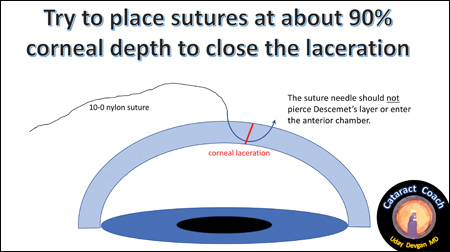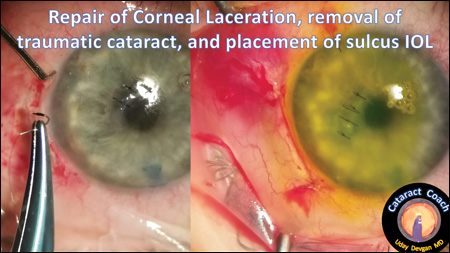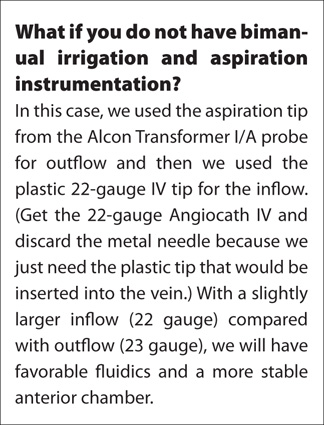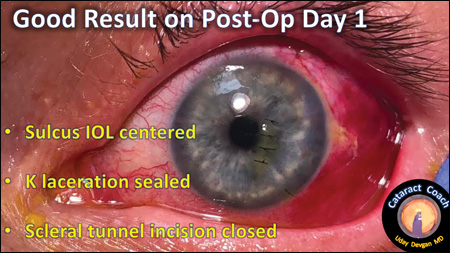Surgical repair of corneal laceration and anterior lens capsule rupture
Surgeons use a stepwise approach for this traumatic ocular injury.
A patient presents to our resident ophthalmology clinic with a 1-day history of a nail piercing his eye while doing construction work. Fortunately, the trauma is not high speed and the damage is limited to the anterior segment of the eye. There is a central corneal laceration and the anterior lens capsule has been ruptured, as seen in Figure 1. The posterior lens capsule is intact, and there is no posterior segment trauma. No retained foreign bodies are found.
There are three options for surgical repair:
1. Close the corneal laceration and defer the cataract removal for later;
2. Close the corneal laceration, remove the cataract and leave the eye aphakic; or
3. Close the corneal laceration, remove the cataract and place the IOL.
The decision is left up to the surgeon’s judgment given the specific clinical situation. Note that implanting an IOL should be avoided in cases in which there is a high likelihood of infection as it is difficult to clear an infection with any sort of hardware, such as an IOL, in the eye.
A stepwise approach is used to repair this traumatic ocular injury.

Source: Uday Devgan, MD

1. The full extent of the trauma is determined while the patient is under anesthesia. The eye is dilated with a mixture of 1:6,000 epinephrine in balanced salt solution, and the anterior lens capsule is stained with trypan blue dye.
2. The anterior chamber is formed with dispersive viscoelastic until a normal corneal contour is achieved.
3. Using 10-0 nylon sutures, the corneal laceration is closed until it is mostly watertight. Place these sutures at 90% corneal depth without penetrating Descemet’s membrane (Figure 2). At this step, a little leakage is tolerable.
4. If possible, convert a small rupture of the anterior lens capsule into a capsulorrhexis. In this case, the anterior capsular rupture is large, and we use a cystotome to perform a can opener-style capsular opening.
5. Because the patient is young and the lens is soft, it can be easily aspirated using bimanual irrigation-aspiration. Using two slightly enlarged paracentesis incisions (about 1.2 mm each), remove the entire lens, being careful not to grab the capsule or cause a posterior capsular extension of a capsular tag. Use a high vacuum (500 mm Hg), low flow (30 cc/min) and moderate infusion pressure (50 mm Hg infusion pressure or 75 cm bottle height).
6. Fill the capsular bag and anterior chamber with cohesive viscoelastic and create a scleral tunnel incision for IOL placement. We avoid using a corneal incision for IOL placement because the cornea has sustained trauma and we want to avoid stressing it further.


7. Here we used a three-piece IOL based on calculations of the contralateral eye and then conversion to sulcus power. The IOL is placed into the sulcus, and then the scleral tunnel is sutured closed (Figure 3). Note that we still have viscoelastic in the eye.
8. Now we can do further suturing of the corneal incision, which is easier with the viscoelastic in the eye. When the cornea is completely closed, we can remove the viscoelastic.
9. Remove the viscoelastic using the bimanual instrumentation, this time with a higher flow rate (40 cc/min), higher infusion pressure (70 mm Hg or 100 cm bottle height) and the same high vacuum level (500 mm Hg).
10. Now check the cornea again, this time using a fluorescein dye leakage test. Any leaking should be addressed with careful suturing. Also, make sure you bury the knots so that the corneal surface is smooth. Be careful with corneal suturing because each pass will tend to macerate the delicate tissue. You cannot attempt the same suture multiple times in the same location without destroying valuable corneal tissue.

11. Close the conjunctiva over the scleral tunnel. Inject subconjunctival antibiotics and steroids. For postop pain control, you may want to consider giving a retrobulbar injection of a long-acting local anesthetic such as bupivacaine (Marcaine). Patch and shield the eye. Consider giving systemic acetazolamide (Diamox) for IOP control, particularly if you feel that you may have left some viscoelastic in the eye.
Watch the patient closely in the post-op period and be sure to set reasonable expectations. Although the postop result looks great, those central corneal sutures are inducing irregular astigmatism and limiting the vision to 20/200 (Figure 4).
Go online to CataractCoach.com for more details of this case and surgical video.
- For more information:
- Uday Devgan, MD, is in private practice at Devgan Eye Surgery, Chief of Ophthalmology at Olive View UCLA Medical Center and Clinical Professor of Ophthalmology at the Jules Stein Eye Institute, UCLA School of Medicine. He can be reached at 11600 Wilshire Blvd. #200, Los Angeles, CA 90025; email: devgan@gmail.com; website: www.CataractCoach.com.
Disclosure: Devgan reports no relevant financial disclosures.
